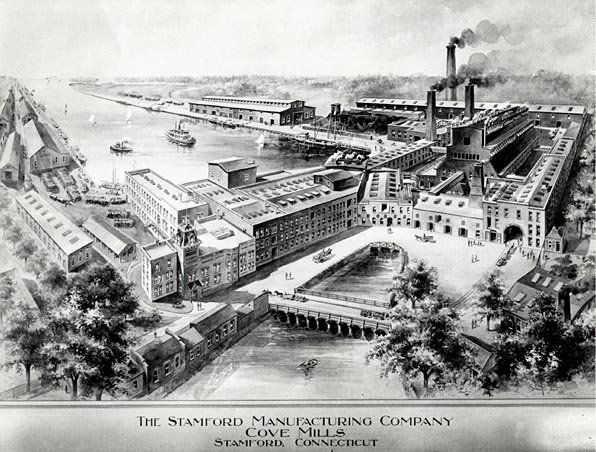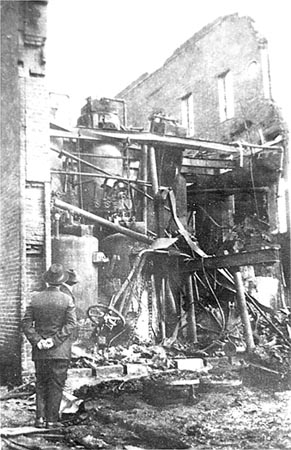| Join | Official Historian | City of Stamford | Blog | About Us | |
| Jewish Historical Society | Civil War Roundtable | Contact Us | |
|
|
|
|
Famous Cove Mills Perish in Stamford's Biggest Fire (1919)from Newsletter, Volume 49, Issue 1, The Stamford Historical Society
About 100 workers were in the plant. A strong northwest wind spread the flames quickly as firebrands leap-frogged across the giant complex. All the firefighting apparatus from Stamford, Noroton Heights, Glenbrook and Springdale, the strategic fire hydrants, and the firewalled brick construction proved powerless. The flames lit up the sky with vivid colors, drawing thousands of spectators to the high ground around the plant. The drama was startling as boilers blew up, extract vats popped and massive brick walls tumbled. Fortunately the terrifying sparks flew mostly toward the Sound, away from nearby homes, though some owners took furniture outside for safety. Firebrands hit General Skiddy's Pound Rocks mansion and the Holly house, now SoundWaters Inc. HQ, but residents on the roofs and firemen saved them. Spectators were most concerned when two barges, loosed from their wharves, were blown into the Sound with two women and three men needing rescue. All major factory buildings, machine shops, laboratories, storage buildings, etc. were destroyed. Among them were three large three-story brick buildings up to 300 ft. long, a metal- clad steel building 200 ft. long, and a large two-story wooden building. Three tall chimneys, one 126 ft. high, stood "like loyal, weary sentinels" over the jumbled kilns and smoldering, twisted rubble. The office building survived, as did a small brick building to the north that still stands. Started in 1792 as a small tidewater gristmill on the eastern edge of Cove Island, Stamford Manufacturing Co. grew to become Stamford's largest industry and the world's largest dye extracting concern. At its peak in 1890 it employed about 500 workers, with state-of-the-art facilities on 70 acres at the Cove, thousands of feet of mechanized wharves hosting big deep-sea schooners, a shipping company with four schooners, and a number of houses on Weed Street.
Stamford Manufacturing Co. was truly a pioneer in applying science to haphazard processes. In 1832, age-old dyewood dyes were primitive, but very popular. Aggressive research in critical areas such as mordants and process techniques gave the company the lead in the accuracy, reliability and consulting services sorely needed by the booming textile industry. But in the early 1900's, the company fell behind. Aniline dyes took over in textiles and tanning. Drug extracts and the licorice boom phased out. Reorganized as the Stamford Extract Manufacturing Co., the owners discovered it was more important to own a market than a mill. On February 20th, 1919, they didn't even own a mill. RG-7:
Cove Mills |
|
|
|

 At 7:00 in the
evening of February 19, 1919, a small fire started in the acid storage room
of the
huge Cove Mills, a complex of about
25 "fireproof" buildings sprawled over western Cove Island and well up Cove
Road. It rapidly became the most spectacular, most destructive fire in Stamford
history.
At 7:00 in the
evening of February 19, 1919, a small fire started in the acid storage room
of the
huge Cove Mills, a complex of about
25 "fireproof" buildings sprawled over western Cove Island and well up Cove
Road. It rapidly became the most spectacular, most destructive fire in Stamford
history.